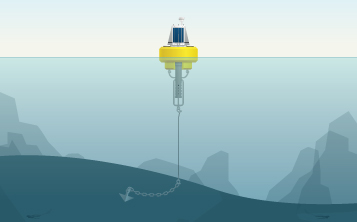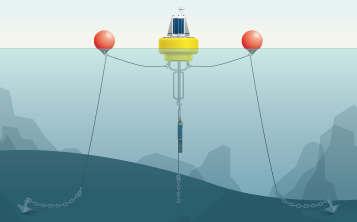Buoy Mooring
A buoy-based system must be moored to ensure that it remains stationary. The buoy is usually moored via a stainless steel mooring line, bottom chain and anchor. It is recommended to moor the buoy in the deepest part of the waterway to ensure the most inclusive measurements. This allows for multiple measurement depths and will best reflect the characteristics of the water body as a whole.
Buoy-based systems are typically moored as either a single-point or two-point mooring, based on environmental and application-specific factors.
Single-Point Mooring
 Single-point moorings are not common, but they require the least amount of mooring equipment. This setup can be deployed in very calm waters with minimal instruments. A single-point mooring should only be used when all sensors and equipment are housed within an instrument cage or deployment pipe. Hanging sensors risk getting damaged or entangled with the anchor line. A cage or pipe protects the instruments from entanglement, subsurface debris, and currents without affecting sensor readings.
Single-point moorings are not common, but they require the least amount of mooring equipment. This setup can be deployed in very calm waters with minimal instruments. A single-point mooring should only be used when all sensors and equipment are housed within an instrument cage or deployment pipe. Hanging sensors risk getting damaged or entangled with the anchor line. A cage or pipe protects the instruments from entanglement, subsurface debris, and currents without affecting sensor readings.
In a single-point configuration, a mooring line connects the buoy directly to a bottom chain and anchor. The sensors are typically housed within a central deployment pipe or attached to a rigid instrument cage. The anchor, bottom chain, and mooring line are assembled and attached to the buoy prior to deploying the system.
Two-Point Mooring
 Two-point moorings are the most common deployment configuration. This is the recommended setup if sensors will be hanging at multiple depths in the water column. In a two-point setup, the mooring lines are pulled away from the data buoy by two smaller marker buoys. This configuration leaves the water column below the buoy available for sensors, without risk of entanglement with anchor lines. It also offers greater stability if there are currents or wave action at the location.
Two-point moorings are the most common deployment configuration. This is the recommended setup if sensors will be hanging at multiple depths in the water column. In a two-point setup, the mooring lines are pulled away from the data buoy by two smaller marker buoys. This configuration leaves the water column below the buoy available for sensors, without risk of entanglement with anchor lines. It also offers greater stability if there are currents or wave action at the location.
A two-point mooring requires a larger deployment area than a single-point mooring, as the marker buoys are typically set about ten feet away from the data buoy. Additional mooring lines run from the marker buoys to bottom chains and anchors at the seafloor. The increased system stability from the two anchor setup is well worth the extra equipment, as is the expanded area for hanging sensors. If there is significant subsurface debris or other risks present, deployment pipes or instrument cages can still be used.
Cite This Work
Fondriest Environmental, Inc. “Buoy Mooring.” Fundamentals of Environmental Measurements. 24 Apr. 2014. Web. < https://www.fondriest.com/environmental-measurements/monitoring-equipment/buoy-mooring/ >.





